Xunying Liu
MOPSA: Mixture of Prompt-Experts Based Speaker Adaptation for Elderly Speech Recognition
May 30, 2025Abstract:This paper proposes a novel Mixture of Prompt-Experts based Speaker Adaptation approach (MOPSA) for elderly speech recognition. It allows zero-shot, real-time adaptation to unseen speakers, and leverages domain knowledge tailored to elderly speakers. Top-K most distinctive speaker prompt clusters derived using K-means serve as experts. A router network is trained to dynamically combine clustered prompt-experts. Acoustic and language level variability among elderly speakers are modelled using separate encoder and decoder prompts for Whisper. Experiments on the English DementiaBank Pitt and Cantonese JCCOCC MoCA elderly speech datasets suggest that online MOPSA adaptation outperforms the speaker-independent (SI) model by statistically significant word error rate (WER) or character error rate (CER) reductions of 0.86% and 1.47% absolute (4.21% and 5.40% relative). Real-time factor (RTF) speed-up ratios of up to 16.12 times are obtained over offline batch-mode adaptation.
Towards LLM-Empowered Fine-Grained Speech Descriptors for Explainable Emotion Recognition
May 29, 2025Abstract:This paper presents a novel end-to-end LLM-empowered explainable speech emotion recognition (SER) approach. Fine-grained speech emotion descriptor (SED) features, e.g., pitch, tone and emphasis, are disentangled from HuBERT SSL representations via alternating LLM fine-tuning to joint SER-SED prediction and ASR tasks. VAE compressed HuBERT features derived via Information Bottleneck (IB) are used to adjust feature granularity. Experiments on the IEMOCAP and MELD benchmarks demonstrate that our approach consistently outperforms comparable LLaMA-based SER baselines, including those using either (a) alternating multi-task fine-tuning alone or (b) feature disentanglement only. Statistically significant increase of SER unweighted accuracy by up to 4.0% and 3.7% absolute (5.4% and 6.6% relative) are obtained. More importantly, emotion descriptors offer further explainability for SER.
Effective and Efficient One-pass Compression of Speech Foundation Models Using Sparsity-aware Self-pinching Gates
May 28, 2025Abstract:This paper presents a novel approach for speech foundation models compression that tightly integrates model pruning and parameter update into a single stage. Highly compact layer-level tied self-pinching gates each containing only a single learnable threshold are jointly trained with uncompressed models and used in fine-grained neuron level pruning. Experiments conducted on the LibriSpeech-100hr corpus suggest that our approach reduces the number of parameters of wav2vec2.0-base and HuBERT-large models by 65% and 60% respectively, while incurring no statistically significant word error rate (WER) increase on the test-clean dataset. Compared to previously published methods on the same task, our approach not only achieves the lowest WER of 7.05% on the test-clean dataset under a comparable model compression ratio of 4.26x, but also operates with at least 25% less model compression time.
On-the-fly Routing for Zero-shot MoE Speaker Adaptation of Speech Foundation Models for Dysarthric Speech Recognition
May 28, 2025Abstract:This paper proposes a novel MoE-based speaker adaptation framework for foundation models based dysarthric speech recognition. This approach enables zero-shot adaptation and real-time processing while incorporating domain knowledge. Speech impairment severity and gender conditioned adapter experts are dynamically combined using on-the-fly predicted speaker-dependent routing parameters. KL-divergence is used to further enforce diversity among experts and their generalization to unseen speakers. Experimental results on the UASpeech corpus suggest that on-the-fly MoE-based adaptation produces statistically significant WER reductions of up to 1.34% absolute (6.36% relative) over the unadapted baseline HuBERT/WavLM models. Consistent WER reductions of up to 2.55% absolute (11.44% relative) and RTF speedups of up to 7 times are obtained over batch-mode adaptation across varying speaker-level data quantities. The lowest published WER of 16.35% (46.77% on very low intelligibility) is obtained.
Towards One-bit ASR: Extremely Low-bit Conformer Quantization Using Co-training and Stochastic Precision
May 27, 2025Abstract:Model compression has become an emerging need as the sizes of modern speech systems rapidly increase. In this paper, we study model weight quantization, which directly reduces the memory footprint to accommodate computationally resource-constrained applications. We propose novel approaches to perform extremely low-bit (i.e., 2-bit and 1-bit) quantization of Conformer automatic speech recognition systems using multiple precision model co-training, stochastic precision, and tensor-wise learnable scaling factors to alleviate quantization incurred performance loss. The proposed methods can achieve performance-lossless 2-bit and 1-bit quantization of Conformer ASR systems trained with the 300-hr Switchboard and 960-hr LibriSpeech corpus. Maximum overall performance-lossless compression ratios of 16.2 and 16.6 times are achieved without a statistically significant increase in the word error rate (WER) over the full precision baseline systems, respectively.
Unfolding A Few Structures for The Many: Memory-Efficient Compression of Conformer and Speech Foundation Models
May 27, 2025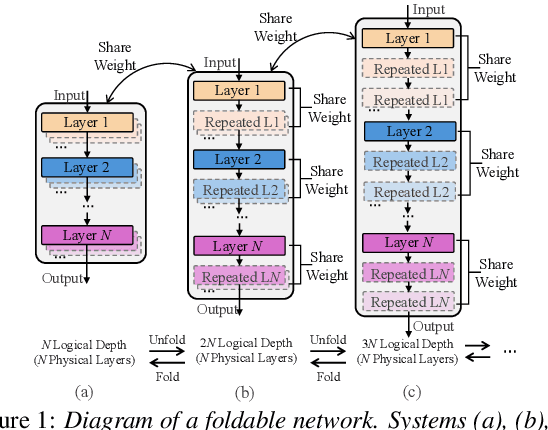
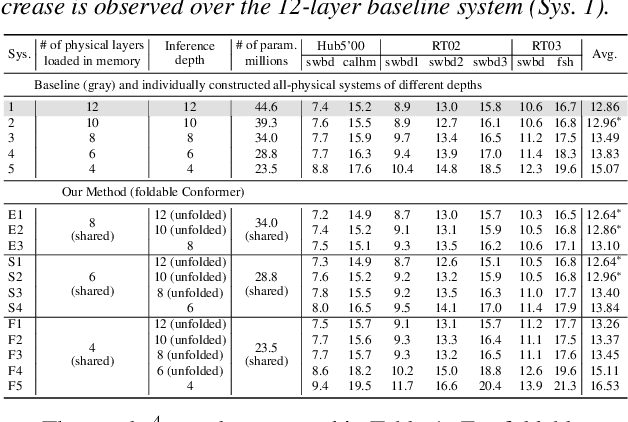
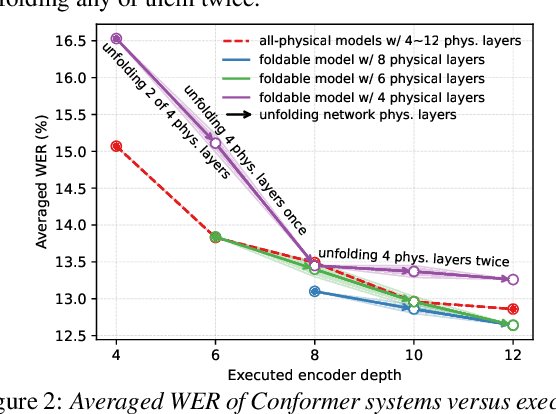
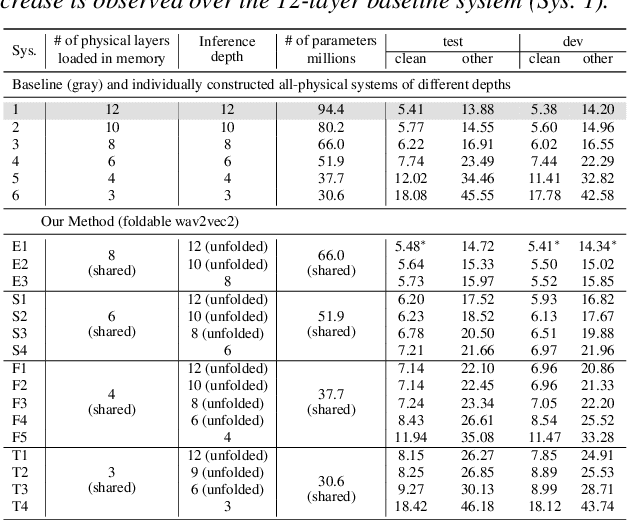
Abstract:This paper presents a novel memory-efficient model compression approach for Conformer ASR and speech foundation systems. Our approach features a unique "small-to-large" design. A compact "seed" model containing a few Conformer or Transformer blocks is trained and unfolded many times to emulate the performance of larger uncompressed models with different logical depths. The seed model and many unfolded paths are jointly trained within a single unfolding cycle. The KL-divergence between the largest unfolded and smallest seed models is used in a self-distillation process to minimize their performance disparity. Experimental results show that our foldable model produces ASR performance comparable to individually constructed Conformer and wav2vec2/HuBERT speech foundation models under various depth configurations, while requiring only minimal memory and storage. Conformer and wav2vec2 models with a reduction of 35% and 30% parameters are obtained without loss of performance, respectively.
Efficient Adapter Tuning for Joint Singing Voice Beat and Downbeat Tracking with Self-supervised Learning Features
Mar 13, 2025Abstract:Singing voice beat tracking is a challenging task, due to the lack of musical accompaniment that often contains robust rhythmic and harmonic patterns, something most existing beat tracking systems utilize and can be essential for estimating beats. In this paper, a novel temporal convolutional network-based beat-tracking approach featuring self-supervised learning (SSL) representations and adapter tuning is proposed to track the beat and downbeat of singing voices jointly. The SSL DistilHuBERT representations are utilized to capture the semantic information of singing voices and are further fused with the generic spectral features to facilitate beat estimation. Sources of variabilities that are particularly prominent with the non-homogeneous singing voice data are reduced by the efficient adapter tuning. Extensive experiments show that feature fusion and adapter tuning improve the performance individually, and the combination of both leads to significantly better performances than the un-adapted baseline system, with up to 31.6% and 42.4% absolute F1-score improvements on beat and downbeat tracking, respectively.
Phone-purity Guided Discrete Tokens for Dysarthric Speech Recognition
Jan 08, 2025



Abstract:Discrete tokens extracted provide efficient and domain adaptable speech features. Their application to disordered speech that exhibits articulation imprecision and large mismatch against normal voice remains unexplored. To improve their phonetic discrimination that is weakened during unsupervised K-means or vector quantization of continuous features, this paper proposes novel phone-purity guided (PPG) discrete tokens for dysarthric speech recognition. Phonetic label supervision is used to regularize maximum likelihood and reconstruction error costs used in standard K-means and VAE-VQ based discrete token extraction. Experiments conducted on the UASpeech corpus suggest that the proposed PPG discrete token features extracted from HuBERT consistently outperform hybrid TDNN and End-to-End (E2E) Conformer systems using non-PPG based K-means or VAE-VQ tokens across varying codebook sizes by statistically significant word error rate (WER) reductions up to 0.99\% and 1.77\% absolute (3.21\% and 4.82\% relative) respectively on the UASpeech test set of 16 dysarthric speakers. The lowest WER of 23.25\% was obtained by combining systems using different token features. Consistent improvements on the phone purity metric were also achieved. T-SNE visualization further demonstrates sharper decision boundaries were produced between K-means/VAE-VQ clusters after introducing phone-purity guidance.
Detecting Neurocognitive Disorders through Analyses of Topic Evolution and Cross-modal Consistency in Visual-Stimulated Narratives
Jan 07, 2025



Abstract:Early detection of neurocognitive disorders (NCDs) is crucial for timely intervention and disease management. Speech analysis offers a non-intrusive and scalable screening method, particularly through narrative tasks in neuropsychological assessment tools. Traditional narrative analysis often focuses on local indicators in microstructure, such as word usage and syntax. While these features provide insights into language production abilities, they often fail to capture global narrative patterns, or microstructures. Macrostructures include coherence, thematic organization, and logical progressions, reflecting essential cognitive skills potentially critical for recognizing NCDs. Addressing this gap, we propose to investigate specific cognitive and linguistic challenges by analyzing topical shifts, temporal dynamics, and the coherence of narratives over time, aiming to reveal cognitive deficits by identifying narrative impairments, and exploring their impact on communication and cognition. The investigation is based on the CU-MARVEL Rabbit Story corpus, which comprises recordings of a story-telling task from 758 older adults. We developed two approaches: the Dynamic Topic Models (DTM)-based temporal analysis to examine the evolution of topics over time, and the Text-Image Temporal Alignment Network (TITAN) to evaluate the coherence between spoken narratives and visual stimuli. DTM-based approach validated the effectiveness of dynamic topic consistency as a macrostructural metric (F1=0.61, AUC=0.78). The TITAN approach achieved the highest performance (F1=0.72, AUC=0.81), surpassing established microstructural and macrostructural feature sets. Cross-comparison and regression tasks further demonstrated the effectiveness of proposed dynamic macrostructural modeling approaches for NCD detection.
Effective and Efficient Mixed Precision Quantization of Speech Foundation Models
Jan 07, 2025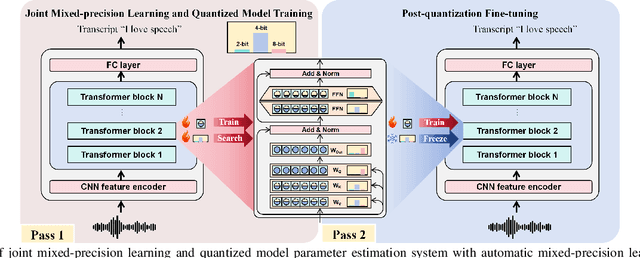
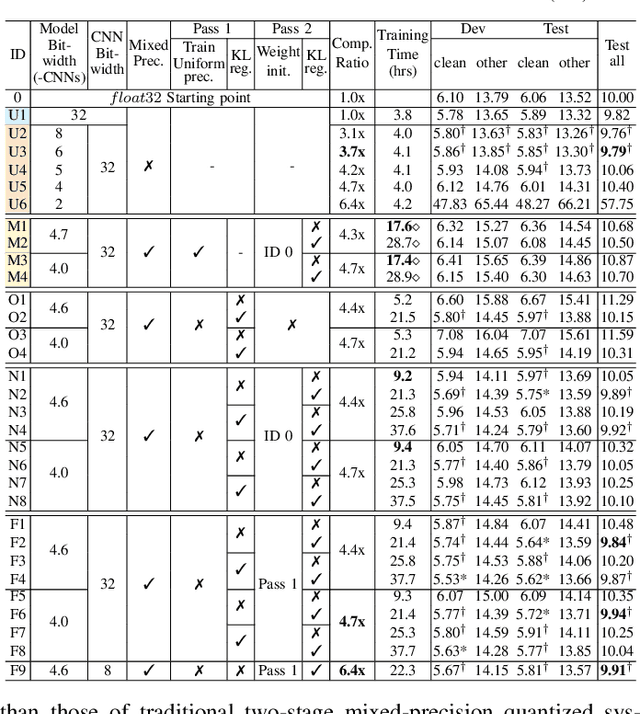
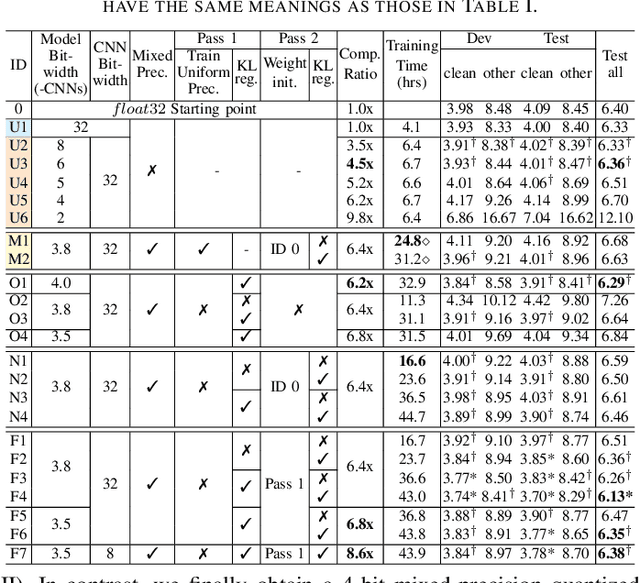
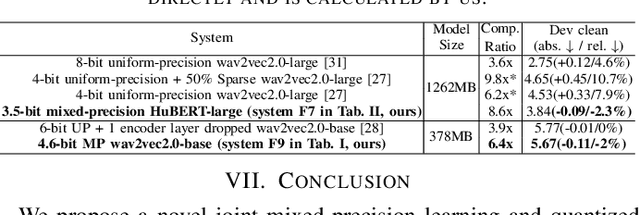
Abstract:This paper presents a novel mixed-precision quantization approach for speech foundation models that tightly integrates mixed-precision learning and quantized model parameter estimation into one single model compression stage. Experiments conducted on LibriSpeech dataset with fine-tuned wav2vec2.0-base and HuBERT-large models suggest the resulting mixed-precision quantized models increased the lossless compression ratio by factors up to 1.7x and 1.9x over the respective uniform-precision and two-stage mixed-precision quantized baselines that perform precision learning and model parameters quantization in separate and disjointed stages, while incurring no statistically word error rate (WER) increase over the 32-bit full-precision models. The system compression time of wav2vec2.0-base and HuBERT-large models is reduced by up to 1.9 and 1.5 times over the two-stage mixed-precision baselines, while both produce lower WERs. The best-performing 3.5-bit mixed-precision quantized HuBERT-large model produces a lossless compression ratio of 8.6x over the 32-bit full-precision system.
 Add to Chrome
Add to Chrome Add to Firefox
Add to Firefox Add to Edge
Add to Edge